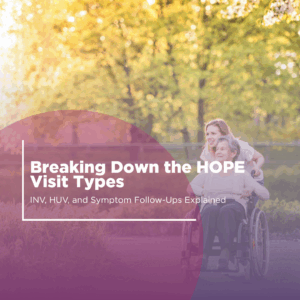Breaking Down the HOPE Visit Types: INV, HUV, and Symptom Follow-Ups Explained
The HOPE (Hospice Outcomes & Patient Evaluation) model introduces a new rhythm to hospice documentation, one that centers on the patient’s evolving experience of care. To meet HOPE’s standards with confidence, it’s critical to understand the different visit types and their timing.
Let’s break down the three visit types defined by HOPE: INV, HUV, and Symptom Follow-Ups, so your team knows exactly what’s required, when, and why it matters.
1. INV – Initial Nursing Visit
What it is: The first clinical touchpoint in the HOPE timeline. The INV marks the beginning of structured data collection and sets the baseline for all subsequent updates.
When it’s due: As soon as possible after admission, ideally within the first day.
What it captures:
- Key demographic and clinical data
- Initial symptom impact ratings
- Observations that may trigger a future follow-up
In Curantis Solutions:
Once the INV is completed and passes QA, Curantis automatically creates the HOPE Admission File and evaluates for any required Symptom Follow-Up Visits.
2. HUV – HOPE Update Visits
HOPE requires two follow-up check-ins to capture how the patient’s condition is changing over time. These are called HOPE Update Visits—HUV1 and HUV2.
HUV1
When it’s due: Days 6–15 after admission
Purpose: Reassess symptoms and update the patient’s status.
HUV2
When it’s due: Days 16–30 after admission
Purpose: Continue tracking trends and changes, especially as patients stabilize or begin to decline.
In Curantis Solutions:
At the start of any visit, clinicians are prompted to confirm whether it will be a HOPE Update Visit. If yes, the system enables a HOPE Preview and auto-generates the update file after QA completion.
Pro tip: Even if the visit wasn’t originally intended as a HOPE Update Visit, clinicians can update their response at visit close ensuring the right file is created.
3. Symptom Follow -Up Visits
What they are:
Special visits required when certain symptoms (e.g., pain, shortness of breath, anxiety) are rated as having a moderate or severe impact on the patient’s well-being.
When they’re due:
Time-sensitive, must occur within days of the symptom being flagged.
Why they matter:
These follow-ups are the heart of HOPE’s patient-centered approach. They ensure that care plans are adapted quickly and that patients don’t suffer in silence.
In Curantis Solutions:
Symptom follow-ups are:
- Automatically evaluated after each visit
- Clearly flagged with alerts across the system
- Auto-documented into the HOPE record upon completion and QA
Want to see HOPE visit tracking in action?
To support you every step of the way, we’ve created the HOPE Hub—a dedicated resource center designed to guide your team through a seamless transition to HOPE-based documentation. For more HOPE Resources, visit here.
Contact us today to schedule a demo and see how we’re reimagining hospice and palliative care to make your software experience refreshingly simple.





